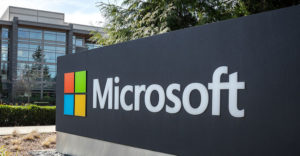Microsoft on Monday unveiled an ambitious plan that would use technology found in the television white space spectrum to develop affordable broadband Internet access for at least 2 million consumers. [*Editor’s Note – July 13, 2017]
The aim is to bridge the technology gap between urban and rural American communities.
The spectrum is a currently unused portion in the 600 Mhz frequency range designated for UHF television bands, which allows wireless signals to travel over hills and through buildings and trees into rural areas.
Microsoft has deployed 20 such projects in 17 countries around the world, including Columbia, Kenya and Jamaica, providing access to a total of 185,000 people.
Microsoft President Brad Smith outlined the plan at a high-powered luncheon in Washington, D.C., which was sponsored by the Media Institute.
Thirty-four million Americans still lack access to broadband, he pointed out, and although 23 million still live in rural areas, progress for broadband penetration in the country has plateaued.
“This it not just about watching YouTube videos on tablets, as enjoyable as that may be,” Smith told attendees at the luncheon. It’s about education. It’s about healthcare. It’s about agriculture and growing a small business. It is a vital part of modern day life.”
Business Case
Microsoft issued a white paper on the rural broadband gap and how best to approach it, based on research from Boston Consulting Group.
Eighty percent of rural areas would benefit from the white spaces spectrum for populations of 2 to 200 people per square mile, according to the paper. Satellite coverage would work best for smaller communities, while fixed wireless would best serve more densely populated areas.
Microsoft will work with a group of investment partners through its Rural Airband Initiative to have 12 different projects up and running over the next 12 months in 12 different states, Smith said. The company will make initial investments in capital costs and then work with local operators on a revenue-share plan to recoup investments.
Microsoft also has partnered with the National 4-H Council to train people on the latest technology. Deployment of the broadband initiative will improve Internet access for students in local schools, provide telemedicine in rural hospitals, and offer access to greater opportunities to employ precision farming, which uses sensors to estimate the specific needs for water and other resources. It also will aid small businesses and individual consumers.
The effort is meant to be a catalyst for a larger industry-wide plan that could expand broadband to the nation’s rural population at a cost of between US$8 billion and $12 billion over a five-year period. Such a plan would cost 80 percent less than the cost of fiber alone and 50 percent less than using fixed wireless technology like 4G, the company said.
Microsoft has not specified a cost attached to its own 12-state plan, but said it planned to reach out to additional partners and that the public sector would need to play a role for expanded broadband coverage with federal and state infrastructure investment.
FCC Chairman Ajit Pai was in South Boston, Virginia, on Monday, learning more about Microsoft’s efforts to provide broadband service to thousands of students in rural parts of the state.
“The FCC is committed to bridging the digital divide and ensuring that all Americans can enjoy the opportunities provided by high-speed Internet access,” said Tina Pelkey, the FCC’s new press secretary. “We will continue to work in partnership with industry, state and local governments, and the nonprofit community to achieve that goal.”
Public Knowledge has urged the FCC to make greater use of TV white spaces by managing the public airwaves.
“Although the technology has been deployed in some rural communities for high-tech precision farming and some wireless ISPs, the cost of equipment has discouraged widespread adoption,” said Harold Feld, senior vice president of Public Knowledge.
The group has urged the FCC to make the technology more affordable, but resistance from the National Association of Broadcasters has stymied that effort, he told TechNewsWorld.
Promise and Pitfalls
The plan is a positive step, noted Shirley Bloomfield, president of NTCA, the Rural Broadband Association.
However, “even the most cutting-edge technology is going to need lots of fiber backhaul to make a compelling broadband product,” she told TechNewsWorld.
White space spectrum technology is promising, but it’s very expensive unless you get enough users or participating organizations to make it cost-effective, observed broadband technology consultant Craig Settles.
“Microsoft is to white space what Google is to fiber,” he told TechNewsWorld. “Both companies have the money and the market credibility to drive adoption, or at least experimentation with technologies.
In order for the plan to work and make money, Microsoft needs to be able to reach critical mass within a certain time frame. Google has run into that problem with deployment of Google Fiber.
Every once in a while, Microsoft — whose operating system for desktop computers has dominated the industry for years — takes on an initiative that is beyond its comfort zone, said independent telecom analyst Jeff Kagan.
“The future of Microsoft’s business lies in several different areas,” he told TechNewsWorld. “They obviously see this as something that’s important to their business. It plays towards what Microsoft will be tomorrow.”
*ECT News Network editor’s note – July 13, 2017: Our original published version of this story indicated that Microsoft’s plan to provide broadband access for at least 2 million consumers would cost between US$8 billion and $12 billion. However, that amount does not accurately reflect Microsoft’s investment in the overall rural broadband plan, according to company rep Lindsey Lombardi. “The total capital and initial operating cost to eliminate the rural broadband gap falls into a range of $8 to $12 billion,” Microsoft President Brad Smith said. However, Microsoft has not attached a dollar amount to its own spending on the initiative it announced.






















































